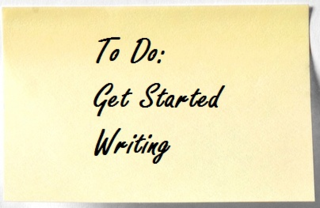Rob Bignell's Blog, page 319
October 15, 2014
Don’t shrug off this bad writing habit
If writing  that a character is shrugging – which is useful when showing he is uncertain or indifferent, depending on the situation – there’s no need to say he is shrugging his shoudlers. That would be redundant as shrugging by definition is to raise one’s shoulder’s slightly.
that a character is shrugging – which is useful when showing he is uncertain or indifferent, depending on the situation – there’s no need to say he is shrugging his shoudlers. That would be redundant as shrugging by definition is to raise one’s shoulder’s slightly.
It’s sort of like writing, “I’ll meet you at 9 a.m. in the morning.” There’s no need to add “in the morning” as “a.m.” by definition is “morning.”
To wit:
WRONG: When asked when the plane from Los Angeles would arrive, Emma shugged her shoulders.
RIGHT: When asked about taking their honeymoon in New York City, Olivia shugged.
Need an editor? Having your book, business document or academic paper proofread or edited before submitting it can prove invaluable. In an economic climate where you face heavy competition, your writing needs a second eye to give you the edge. Whether you come from a big city like Memphis, Tennessee, or a small town like Eastabutchie, Mississippi, I can provide that second eye.
<A HREF="http://ws-na.amazon-adsystem.com/widg... Widgets</A>Related articles
 Delete redundancies for tighter manuscript
Delete redundancies for tighter manuscript When to use affect vs. effect
When to use affect vs. effect How to get rid of Word's proofreading marks
How to get rid of Word's proofreading marks
October 14, 2014
Types of third-person point of views
By far,  the most common point of view used in literature is that of third-person.
the most common point of view used in literature is that of third-person.
When the narrator is not a character in a story, a third-person point of view is being used. All characters in a third-person tale are referred to using pronouns such as he, she, it or they but not I, we or you. The latter three pronouns would place the narrator within the story.
Authors like third-person narration because it offers a tremendous amount of flexibility in plotting and character development. While first-person and second-person points of view limit the writer to the perspectives of a single character, third-person opens the story wide. The story can be told from the viewpoint of several characters, all of whom can grow to varying degrees.
Third-person can be thought about by using two different scales: limited/omniscient and the subjective/objective.
The limited/omniscient scale runs between two extremes. Third-person limited occurs when the narrator tells the story only from the main character’s perspective. In contrast, third-person omniscient allows the narrator to tell the story from multiple characters’ perspectives.
The subjectivity/objectivity scale also stretches between two poles. Third-person subjective (aka third-person intrusive) incorporates the narrator’s commentary about what is occurring in the story and was popular in the 19th century among such writers as Charles Dickens. Third-person objective (aka third-person impersonal or third-person unobtrusive) leaves out the narrator’s editorializing and was championed by such 20th century writers as Ernest Hemingway.
Of course, the two scales can be combined. For example, a story could be written in third-person limited objective, in which the narrator focuses on the perspectives of a lone character and offers no commentary on the story’s action, or it might be in third-person omniscient subjective by telling the tale from the perspectives of multiple characters with commentary from the narrator about the value of their thoughts and actions.
Need an editor? Having your book, business document or academic paper proofread or edited before submitting it can prove invaluable. In an economic climate where you face heavy competition, your writing needs a second eye to give you the edge. Whether you come from a big city like Cleveland, Ohio, or a small town like Roachtown, Illinois, I can provide that second eye.
<A HREF="http://ws-na.amazon-adsystem.com/widg... Widgets</A>Related articles
 Select a viewpoint that gives you flexibility
Select a viewpoint that gives you flexibility
October 13, 2014
Why you can’t get your outline into words
Sometimes despite  penning an outline, the writer can't seem to organize those points into complete sentences and turn it into a draft of a story.
penning an outline, the writer can't seem to organize those points into complete sentences and turn it into a draft of a story.
Is this writer’s block? Probably not. After all, constructing an outline shows that the writer’s creative energy is high.
The problem likely rests with the depth of the outline itself. Take a look at the outline and ask:
g Is the action beat-by-beat? In the extreme, an outline is detailed enough that a writer can literally turn each beat into a complete sentence or two. Anything sketchier than that suggests the author hasn’t thought enough about the plotting, even if they haven’t written it on paper and are merely relying on the outline to jog their memory.
g Are the major characters developed? An outline should give the main character’s motivations and reasons for resolving an issue. Conflicts between characters and the reasons for them should be listed and explored. A story revolves around the characters, so ensuring this is in the outline is vital.
g Does too much offstage action appear in the outline? Rather than focus on the story, sometimes writers create outlines that instead provide lots of exposition and background information. While that is important for an author to know, it doesn't translate well into an actual story.
If the outline does contain beat-by-beat action, developed characters, and plenty of onstage action, then perhaps the problem is the story itself. What was brainstormed for the outline simply may not be the story the writer wants to tell. In such cases, always feel free to deviate from the outline. After all, the outline is just a map, and there are many routes for reaching the story’s end.
Some writers fret over the imperfection of their first draft as they convert an outline into complete sentences. If so, let go! Don't worry about the first draft being just right. Let it be full of incomplete sentences and typos. That's why it's a first rather than a final draft – because it needs to be revised.
Finally, an outline simply isn’t for every writer. Many prefer to free write as they find an outline restrictive and believe it hampers their creative process. If you’re having trouble converting an outline to a first draft, you may be one of those writers. In that case, set the outline aside and just try writing. You might be surprised by the results!
Need an editor? Having your book, business document or academic paper proofread or edited before submitting it can prove invaluable. In an economic climate where you face heavy competition, your writing needs a second eye to give you the edge. Whether you come from a big city like Birmingham, Alabama, or a small town like Buttzville, New Jersey, I can provide that second eye.
Related articles
 Outline your scene when stuck on what to write
Outline your scene when stuck on what to write Improve your writing by dumping fuzzy words
Improve your writing by dumping fuzzy words Mastering the fine art of dialogue punctuation
Mastering the fine art of dialogue punctuation
October 12, 2014
Five Great Quotations about Theme
“In general...there’s  no point in writing hopeless novels. We all know we’re going to die; what’s important is the kind of men and women we are in the face of this.” – Anne Lamott
no point in writing hopeless novels. We all know we’re going to die; what’s important is the kind of men and women we are in the face of this.” – Anne Lamott
“The framework of the artist’s ideas is clearly only that which he is forever seeking for universality, and must be far wider than the framework of the ideals of the patriot.” – Sean O’Faolain
“A story is a stop sign in which ou pause, look both directions, and consider another trajectory over the horizon.” – Kao
“Most writers regard the truth as their most valuable possession, and therefore are most economical in its use.” – Mark Twain
“My work...is to shatter the faith of men here, there, and everywhere, faith in affirmation, faith in negation, and faith in abstention from faith, and this for the sake of faith in faith itself.” – Miguel de Unamuno
Need an editor? Having your book, business document or academic paper proofread or edited before submitting it can prove invaluable. In an economic climate where you face heavy competition, your writing needs a second eye to give you the edge. Whether you come from a big city like Los Angeles, California, or a small town like Hell, Michigan, I can provide that second eye.
<A HREF="http://ws-na.amazon-adsystem.com/widg... Widgets</A>Related articles
 Five great quotations about fiction
Five great quotations about fiction Five great quotations about word choice
Five great quotations about word choice What if I edit out too much exposition?
What if I edit out too much exposition?
October 11, 2014
Affirm your belief in beauty by writing
Perhaps what  sets us apart from the animal kingdom is that we create art. Yes, chimps and elephants both have made paintings while whales and dolphins sing, but no animal on the planet other than humans create with such frequency and variety – clothing, paintings, music, sculpture, architecture, dance, decorative displays, and of course, literature.
sets us apart from the animal kingdom is that we create art. Yes, chimps and elephants both have made paintings while whales and dolphins sing, but no animal on the planet other than humans create with such frequency and variety – clothing, paintings, music, sculpture, architecture, dance, decorative displays, and of course, literature.
The act of creating itself is beautiful if only because so little else expresses our humanity – or our uniqueness as an individual…or imitates and therefore honors our Creator…or brings pleasure to others who experience what we’ve created…or expands our understanding of the universe and all contained within it.
Writing is creation. Through writing, we can understand what being human means. We can understand our own self. We can express the word of God. We can bring laughter and tears and deep introspection to our readers. We can store and share knowledge so others may lead better lives.
By writing, you partake in something greater than yourself. Pick up pen and paper or take a seat at your computer today and create something of beauty.
Need an editor? Having your book, business document or academic paper proofread or edited before submitting it can prove invaluable. In an economic climate where you face heavy competition, your writing needs a second eye to give you the edge. Whether you come from a big city like Boston, Massachusetts, or a small town like Boston, Georgia, I can provide that second eye.
<A HREF="http://ws-na.amazon-adsystem.com/widg... Widgets</A>Related articles
 How to get rid of Word's proofreading marks
How to get rid of Word's proofreading marks Mimic sounds to appeal to sense of hearing
Mimic sounds to appeal to sense of hearing
October 10, 2014
Let bookstore buyers select your cover for you
You’ve got  two or three mockups of your book cover but can’t decide which is best. Nor can your friends or author colleagues who you’ve shown the mockups to. If stuck, consider doing what bestselling author Tim Ferris does: He lets readers browsing in bookstores decide.
two or three mockups of your book cover but can’t decide which is best. Nor can your friends or author colleagues who you’ve shown the mockups to. If stuck, consider doing what bestselling author Tim Ferris does: He lets readers browsing in bookstores decide.
You’ll first need to have a copies of the book printed with each cover. If using a POD house such as CreateSpace, that’s easy enough, albeit a bit time consuming (and carries the expense of shipping). Simply upload one cover and order a proof of it shipped to you. Then upload the second mockup cover and order a proof of it. You’ll need 2-3 weeks to get books with three different covers sent to you.
Next, follow Ferris’ lead. He places each book at his local Barnes & Noble and watches to see which one shoppers pick up first. Do this on a busy Saturday afternoon to maximize the number of people who will pass your books. Also, be discreet when watching; ideally, the book covers will be visible from where you sit in the café.
A crazy idea? Maybe. But Ferris also has three bestselling books to his name, and as the cover typically is what first grabs a potential buyer’s attention, maybe it’s just savvy.
Need an editor? Having your book, business document or academic paper proofread or edited before submitting it can prove invaluable. In an economic climate where you face heavy competition, your writing needs a second eye to give you the edge. Whether you come from a big city like Philadelphia, Pennsylvania, or a small town like Boring, Oregon, I can provide that second eye.
<A HREF="http://ws-na.amazon-adsystem.com/widg... Widgets</A>Related articles
 Distribute ebook on variety of ereaders, tablets
Distribute ebook on variety of ereaders, tablets Avoid these flubs when seeking book signing
Avoid these flubs when seeking book signing Why bookstores don't carry self-published books
Why bookstores don't carry self-published books
October 8, 2014
Make a good investment: Capital vs. capitol
Here’s some  valuable information for authors: the difference between capital and capitol.
valuable information for authors: the difference between capital and capitol.
Capital has a number of definitions, but the one most confused with capitol is when referring to a city that is a governmental or administrative center, as in The capital of Georgia is Atlanta. It also can refer to a city of prominence in some industry or field, as in Detroit is the capital of the auto industry.
Capitol refers to the building where the governing legislature meets, such as The California Assembly was in session at the capitol today.
By memorizing this difference, you now should have good regulation of your writing.
Need an editor? Having your book, business document or academic paper proofread or edited before submitting it can prove invaluable. In an economic climate where you face heavy competition, your writing needs a second eye to give you the edge. Whether you come from a big city like New York, New York, or a small town like Bantam, Connecticut, I can provide that second eye.
<A HREF="http://ws-na.amazon-adsystem.com/widg... Widgets</A>
Related articles
 Don't break circuit of suspense when it's hot
Don't break circuit of suspense when it's hot Capitalize nouns of direct address
Capitalize nouns of direct address How to get rid of Word's proofreading marks
How to get rid of Word's proofreading marks
October 7, 2014
Streamline writing by cutting perception fallacy
When writing f rom a character’s point of view, authors should avoid the perception fallacy. This clunky kind of storytelling assumes that if a tale is being told from a specific character’s point of view, then all description must be filtered directly through that character’s senses and perceptions.
rom a character’s point of view, authors should avoid the perception fallacy. This clunky kind of storytelling assumes that if a tale is being told from a specific character’s point of view, then all description must be filtered directly through that character’s senses and perceptions.
For example, an author would write:
Thales slammed the wax tablet so hard against the table that he heard the children laughing outside suddenly quiet. He threw his door open and saw a triangle of sunlight spread past him into the darkness. “You urchins, get out of here!” he shouted.
But readers don’t need to know that Thales “heard” the children laughing outside quieting or that he “saw” the triangle of sunlight spreading past him. Readers presume he can hear/see that. In any case, that he can hear/see it is largely irrelevant. Still, you’ll want to keep the detail of what was heard or seen in the story, as it moves the plot forward. Given this, a much better way to write the scene would be:
Thales slammed the wax tablet so hard against the table that the children laughing outside quieted. He threw his door open, and a triangle of sunlight spread past him into the darkness. “You urchins, get out of here!” he shouted.
As a story is being told through the lens of the author, filtering it through the character’s perceptions adds an additional lens that slightly blurs the story if only at the edges; such a lens is intrusive. Sometimes to get around this intrusiveness, the novice author will wrongly have another character tell our character what the author wants the reader to see; this actually adds a third lens to the story and often can be even more intrusive.
When the author persists in the perception fallacy, readers ultimately will become confused by exactly what is the author’s perception, the narrator’s perception, and any other character’s perceptions.
David Smith coined the term in an article for SFWA.
Need an editor? Having your book, business document or academic paper proofread or edited before submitting it can prove invaluable. In an economic climate where you face heavy competition, your writing needs a second eye to give you the edge. Whether you come from a big city like Indianapolis, Indiana, or a small town like Monkey's Eyebrow, Kentucky, I can provide that second eye.
<A HREF="http://ws-na.amazon-adsystem.com/widg... Widgets</A>Related articles
 Tighten writing by cutting begin fallacy
Tighten writing by cutting begin fallacy How to write a novel synopsis for a lit agent
How to write a novel synopsis for a lit agent
October 6, 2014
Tighten writing by not countersinking
One way  for an author to slow a story is to employ “countersinking.” A term coined by science fiction writer Lewis Shiner, countersinking involves making explicit the very actions that the story implies. An example is: “We need to hide,” she said, asking him to seek cover.
for an author to slow a story is to employ “countersinking.” A term coined by science fiction writer Lewis Shiner, countersinking involves making explicit the very actions that the story implies. An example is: “We need to hide,” she said, asking him to seek cover.
Countersinking is also known as “expositional redundancy” and for good reason; in the above example, the character’s dialogue already directly states that she thinks they should hide. So why repeat it?
Besides slowing the story’s dramatic momentum, countersinking suggests the author lacks confidence in his or her storytelling ability.
The solution is simple: Cut the redundant wording to tighten your writing. The above example could be rewritten as: “We need to hide,” she said.
Need an editor? Having your book, business document or academic paper proofread or edited before submitting it can prove invaluable. In an economic climate where you face heavy competition, your writing needs a second eye to give you the edge. I can provide that second eye.
Related articles
 When exposition is necessary in a story
When exposition is necessary in a story What if I edit out too much exposition?
What if I edit out too much exposition? Five quotations about writing as self-discovery
Five quotations about writing as self-discovery Five great quotes to inspire you to write
Five great quotes to inspire you to write What to look for when revising your manuscript
What to look for when revising your manuscript
October 5, 2014
Five Great Quotations for Aspiring Authors
“Get it down.  Take chances. It may be bad, but it's the only way you can do anything really good.” – William Faulkner
Take chances. It may be bad, but it's the only way you can do anything really good.” – William Faulkner
“The art of writing is the art of applying the seat of the pants to the seat of the chair.” – Mary Heaton Vorse
“The best way to have a good idea is to have lots of ideas.” – Linus Pauling
“A great deal of talent is lost to the world for want of a little courage.” – Sidney Smith
“By writing much, one learns to write well.” – Robert Southey
Need an editor? Having your book, business document or academic paper proofread or edited before submitting it can prove invaluable. In an economic climate where you face heavy competition, your writing needs a second eye to give you the edge. Whether you come from a big city like San Francisco, California, or a small town like Nimrod, Oregon, I can provide that second eye.
<A HREF="http://ws-na.amazon-adsystem.com/widg... Widgets</A>Related articles
 Five Great Quotations about Business of Writing
Five Great Quotations about Business of Writing Five Great Quotations about Characters
Five Great Quotations about Characters Avoid these flubs when seeking book signing
Avoid these flubs when seeking book signing



